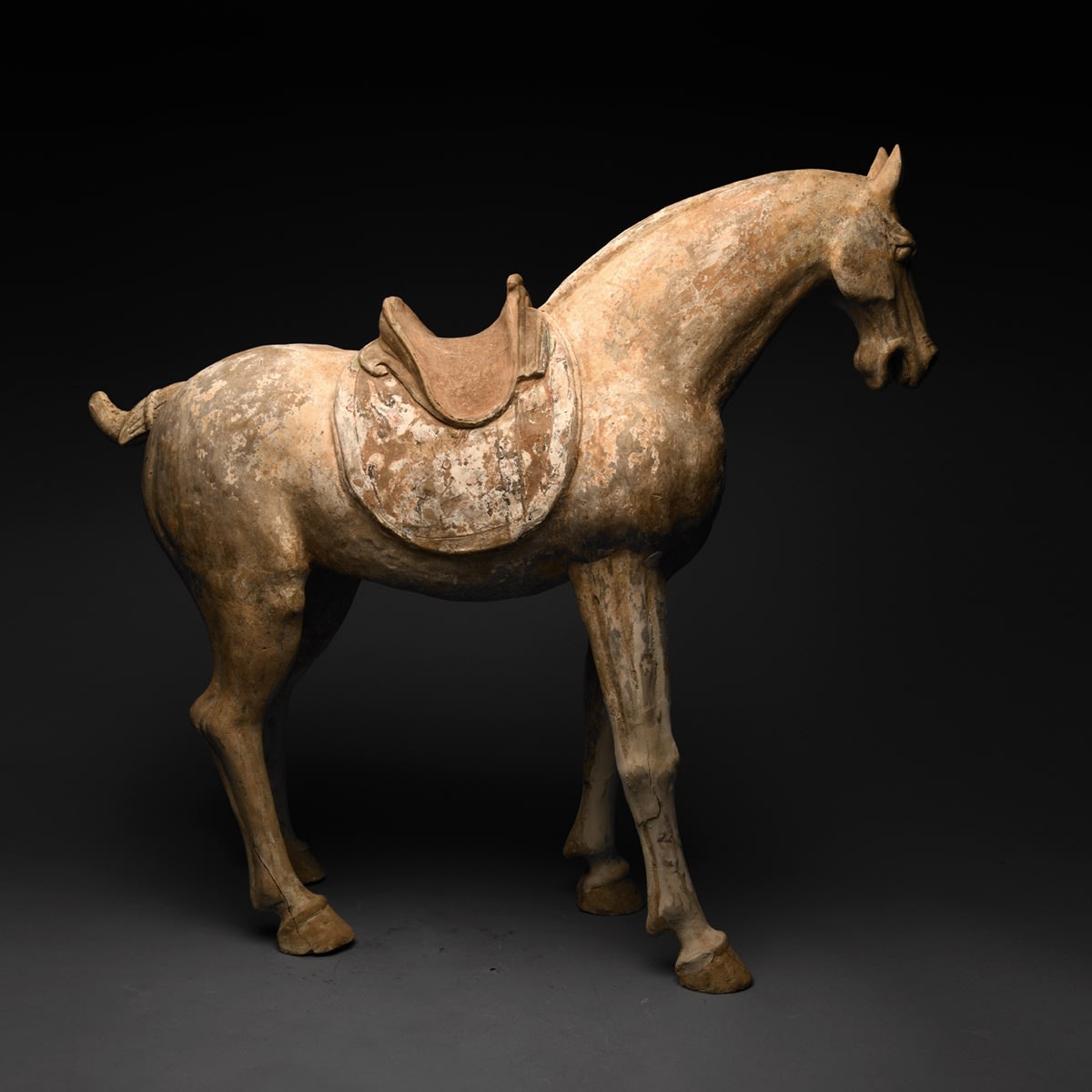Tang Terracotta Sculpture of a Horse with a Painted Saddle, 618 CE - 906 CE
Painted Terracotta
height 61 cm
height 24 in
height 24 in
H.694
Further images
The T’ang Dynasty was an era of unrivalled wealth and luxury. The country was successfully reunified and the borders were expanded, pushing Chinese influence into new lands. Confucianism became a...
The T’ang Dynasty was an era of unrivalled wealth and luxury. The country was successfully reunified and the borders were expanded, pushing Chinese influence into new lands. Confucianism became a semi-religious instrument of the state; yet Buddhism continued to flourish, spreading into Korea and Japan. The arts reached new levels of sophistication. Poetry and literature flourished under the enlightened rulers. The Silk Road brought fortunes into China. Precious treasures were imported on the backs of camels from far away lands and bartered for Chinese silk, medicinal herbs, and pungent spices. T’ang China was a multicultural empire where foreign merchants from across Central Asia and the Middle East settled in the urban centers, foremost among them the thriving capital of Chang’an (modern X’ian), a bustling cosmopolitan center of over two million inhabitants. Foreign traders lived next to native artisans and both thrived. New ideas and exotic artistic forms followed alongside. The T’ang Dynasty was a cultural renaissance where many of the forms and objects we now associate with China were first created. Moreover, this period represents one of the greatest cultural outpourings in human history.
The great influence of the horse throughout the history of China cannot be underestimated. In fact, the ancient expansion of the Chinese Empire was due in large part to the horse. The rapid mobility of horse allowed for quick communication between far away provinces. Likewise, the military role of horses aided in the conquest and submission of distant lands. The need to import stronger, faster steeds from Central Asia (as opposed to the local Mongol pony) led to the creation of the Silk Road. The importance of the horse in the history and culture of China can be viewed, in part, through the artistic legacy of this great civilization. In sculpture, painting, and literature, horses were glorified and revered. Horses were believed to be related to mythological dragons, reflecting their sacred status within society. During the T’ang Dynasty, the adoration of the horse can be seen through their burial art. Horse models excavated from mausoleums of the period are among the most splendid and easily recognizable works of Chinese art.
This impressive, large sculpture of a horse still retains much of its original white pigment in tact. However, even more impressive, is the superb condition of the polychrome painted saddle blanket, featuring a delightful floral pattern painted in red, green, and black hues. The remarkable preservation of this saddle blanket reveals the love and admiration the Chinese had for these majestic creatures, embellishing them with the finest regalia to enhance their natural beauty. This horse steps forward, the muscles of the legs carefully defined. Both the proportions of this horse and its non-removable saddle suggest its origin near Xian (the modern name for the ancient T’ang capital known as Chang’an). This gorgeous sculpture is a testament to the admiration and adoration the Chinese had for this marvelous creatures. Although they were an integral part in the expansion and defense of the empire, they were equally regarded for their beauty and grace as revealed by this sculpture.
The great influence of the horse throughout the history of China cannot be underestimated. In fact, the ancient expansion of the Chinese Empire was due in large part to the horse. The rapid mobility of horse allowed for quick communication between far away provinces. Likewise, the military role of horses aided in the conquest and submission of distant lands. The need to import stronger, faster steeds from Central Asia (as opposed to the local Mongol pony) led to the creation of the Silk Road. The importance of the horse in the history and culture of China can be viewed, in part, through the artistic legacy of this great civilization. In sculpture, painting, and literature, horses were glorified and revered. Horses were believed to be related to mythological dragons, reflecting their sacred status within society. During the T’ang Dynasty, the adoration of the horse can be seen through their burial art. Horse models excavated from mausoleums of the period are among the most splendid and easily recognizable works of Chinese art.
This impressive, large sculpture of a horse still retains much of its original white pigment in tact. However, even more impressive, is the superb condition of the polychrome painted saddle blanket, featuring a delightful floral pattern painted in red, green, and black hues. The remarkable preservation of this saddle blanket reveals the love and admiration the Chinese had for these majestic creatures, embellishing them with the finest regalia to enhance their natural beauty. This horse steps forward, the muscles of the legs carefully defined. Both the proportions of this horse and its non-removable saddle suggest its origin near Xian (the modern name for the ancient T’ang capital known as Chang’an). This gorgeous sculpture is a testament to the admiration and adoration the Chinese had for this marvelous creatures. Although they were an integral part in the expansion and defense of the empire, they were equally regarded for their beauty and grace as revealed by this sculpture.







